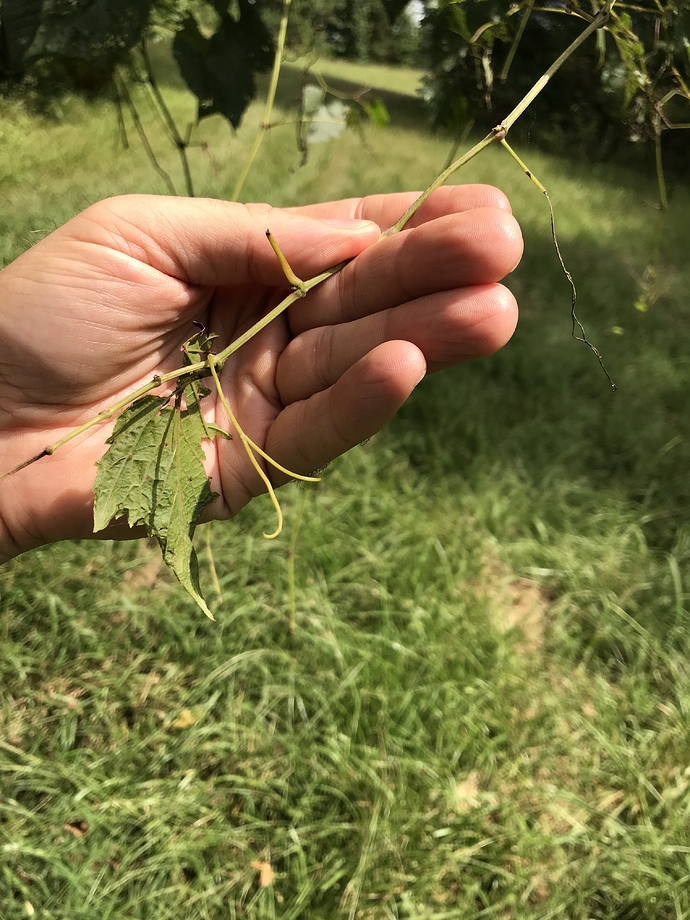I have a farm in central Alabama where I grow some cultivated muscadines and have countless wild vines on the property. I recently came across a vine the likes of which I’ve never seen. The leaves on the vine look like all of the other wild muscadines we have all over the place but the fruit is growing in numerous very heavy clusters unlike anything I’ve seen before. Included are pics I recently took. Is this indeed a muscadine or something entirely different? Any help appreciated!
Definitely looks like a bunch grape to me. Are the tendrils branched or unbranched?
I will need to check that when I go back this weekend. I couldn’t tell from my pics and I didn’t pay attention last time. The vine is very large but the only reason I found it is because it was climbing a young sweet gum tree and the weight of the fruit actually bent the treetop over into the road. We don’t have any native bunch grapes around here to my knowledge so I can’t imagine what led this vine to be here
There are definitely wild bunch grapes in central Alabama. I do see some forked tendrils in your photos, so this is a bunch grape. The general health, lack of rot, along with this vine looking very happy in PD country (Pierce’s Disease), suggests a wild grape. Vitis aestivalis, V. cinerea, and V. cordifolia (aka V. vulpina) are all possible species there. The size of the clusters and the leaves make me lean toward V. cinerea or aestivalis, but I can’t say I have ever seen a wild grape with so many berries per cluster. If it’s cinerea, then the leaves should have a wooly hairiness on the underside of the leaves, although I can’t really see any in the photos. If the leaves are entirely smooth, then it may be some sort of V. cordifolia, or maybe a hybrid. The most important test will come from tasting the ripe fruit. V. cordifolia fruit are usually horrible tasting, while cinerea would be very late ripening and very sour, but probably not too bad. V. aestivalis fruit are usually pretty good when ripe, although acids would still be high.
There are several sub-species of V. aestivalis found in northern Florida and along the gulf coast areas, some with very large clusters, so this may be one of those on the northern edge of their range. Based on the fruit in the first photo, that would be my best guess at this point, with V. cinerea as my second choice.
This is a really healthy and interesting looking grape in an area where few bunch grapes can grow without spray. The berries in your first photo also look a lot bigger than the later pictures. How big are they now? Please kept us updated!
There are several grapes growing in Alabama but unfortunately I don’t know their names. I remember my parents making jelly from them. I only grow muscadines. I’m from a Sylacauga but I now live in St Clair county near Logan Martin lake.
The first picture was taken 2 weeks ago. The second and third ones I posted were actually taken 4-5 weeks ago. I’m going back there tomorrow and will get some better pics and provide an update. Thanks for your insight. Much appreciated!
I just showed the photos to some grape breeding experts, and the consensus was that this is V. cinerea, but maybe with a little cordifolia mixed in. They were also impressed! Looking forward to additional photos. Please try to get close ups of the underside of the leaves, as that is probably the best indication of species. V. cinerea usually ripens very late, so you may have to wait until the first frost for a fair taste test.
Nice photos! Definitely V. cinerea, but the question is which sub-species? There are three known in central Alabama, V. cinerea var. cinerea, V. cinerea var. bailyana, and V. cinerea var. floridana. We can probably rule out bailyana, as those usually have tiny berries and clusters. V. cinerea var. cinerea usually has thicker, very hairy leaves, with tiny berries on very large, open clusters. It can range all the way up the central Illinois. I think your’s is a fine example of V. cinerea var. floridana, also known as Florida Grape. Central Alabama is on the northern edge of the range. These can have a very clean, vinous flavor when fully ripe, but sometimes can also have herbaceous flavors (grassy or green pepper). They are not good for fresh eating, but could actually make a decent wine. If this one has a nice clean flavor, I know some grape breeders that may be interested in a few dormant cuttings next winter.
Here is a link to a page with some info about this grape in Alabama. Note that the counties shown are where specimens were collected, but they probably can be found in the surrounding counties where the same environment is present.
Thanks for the great info! I will keep an eye on the vine as we get into winter and do a taste test late fall/early winter. Will update you then.
I’ve seen a similar vine in West Central Alabama. I thought at the time that it was a hybrid of some sort but did not have enough knowledge of grape species to identify it.






